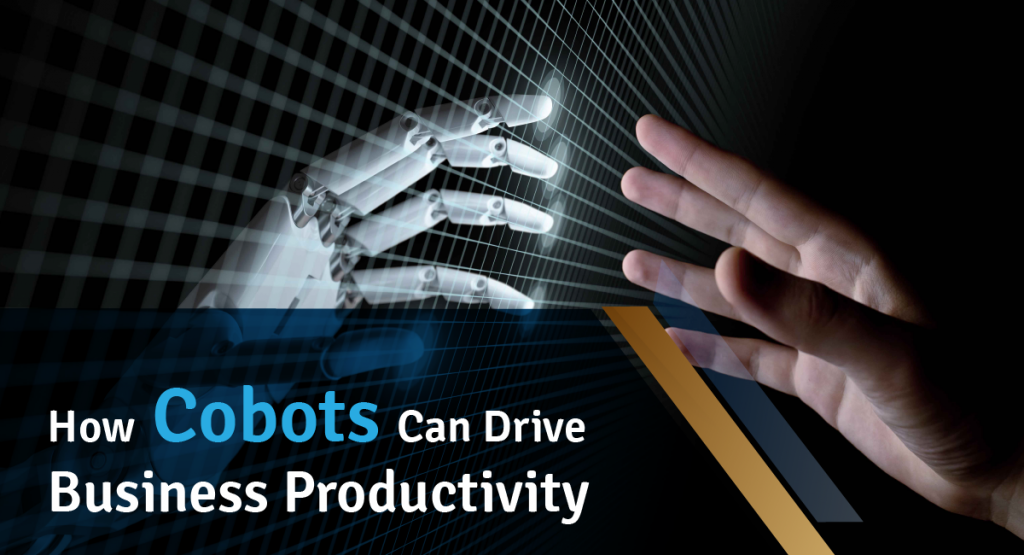
What Are Cobots and How Can They Benefit Industries?
What Are Cobots?
Cobots have been around since the 1990s. Cobots operate in conjunction with humans to perform given tasks. They are built to interact physically with humans in a shared workspace.
In other words, cobots or collaborative robots can be defined as the hardware version of Augmented Intelligence. Rather than replacing humans with their autonomous counterparts, collaborative robots augment artificial intelligence technologies to physical bots. According to Barclays, cobots can revolutionize production. This is effective, especially for smaller companies, that account for 70% of the manufacturing industries, globally.
Cobots help in improving human capabilities in performing tasks with greater strength, accuracy, and data capabilities. The first collaborative robot was a device used to directly interact physically with a manipulator that was computer-controlled’. It was invented by J Edward Colgate and Michael Peshkin in the year 1996. Later, Kuka Robotics launched its first collaborative robot in the year 2004, named LBR 3.
How Are Cobots Useful In Various Industries?
Since Cobots are capable of performing tasks alongside humans instead of replacing them, there is a multitude of ways in which Cobots are used in different industries for varying purposes. The major ones are as follows:
1. Hand–guiding: This cobot has an additional hand – a pressure-sensitive device at the end of its arm. With this arm, the human operator can teach the collaborative robot how to hold an object or how to move, or how fast to move, and so on. It also ensures that nothing gets damaged.
2. Speed and Separation Monitoring Cobots: This particular cobot operates in safety zones. Instead of stopping to perform its task when it senses an outsider’s presence in the safety zone, this cobot slows down and then tracks the location of the human. It stops as the human gets too close.
3. Power And Force Limiting Cobots: These collaborative robots are designed to frequently interact with humans. This specific cobot stops or reverses its movement on encountering any abnormality.
4. Safety Monitored Stop Cobots: These cobots are designed to work independently, but stop whenever a human needs to intervene. This cobot senses human presence and stops all movement until the human has left the safety zone.
How Collaborative Robots Offer Game-Changing Benefits
Cobots have been brewing in the web-space for quite some time. In general, robots have replaced human labor from the industrial workforce since the industrial revolution. Robots, but operated within safe environments. Cobots, on the other hand, help in putting away some of the major spatial and environmental dangers that robots may cause, whilst working alongside humans!
Cobots can also be easily reprogrammed. Many businesses and industries are skeptical about falling behind their competitors, especially in situations where irrecoverable disasters are likely to take place. Here is when cobots can be an effective solution. Let us walk through the major benefits that collaborative robots offer in various industries:
1. Increased and efficient Human-Robot Interaction
In any given industry utilizing bots for performing tedious tasks, time, cost, and floor space are the three major critical factors to be considered. This is because the operator can work alongside the cobot, without having to leave the workspace. Cobots are known to reduce idle time of human workforce by 85%.
Consider a traditional assembly line that is set up in a workspace. Here the human workforce sets up the mechanical robots with required parts to perform the rest of the tasks. The entire production will be put to halt for a long time or stopped from its current operations, in case of any required human intervention. While on the other hand, a collaborative robot works along with the human workforce, which increases the efficiency significantly.
2. Applicable To Small And Mid-Sized Industries
Strategies to optimize costs are a major concern in every industry. This is because larger industries that have a higher production volume prefer a robot to perform tedious tasks. On the other hand, smaller industries prefer manual labor.
Implementing cobots can be beneficial across a range of industry sizes, as these bots do not require a heavy set up process.
3. Safety In Handling Dangerous And Tedious Tasks
Preventing human error is critical in every industry. For instance, steadying the movement of tools used in surgeries is complex. The process needs to be highly accurate as well. Cobots ensure a safer working environment by preventing human errors that can hinder operation accuracies.
4. Increased ROI
Cobots can be conveniently relocated whenever required. This makes it easy to eliminate any non-productive activities during working hours. In addition to being highly efficient and flexible, cobots ensure increased ROI due to significantly reduced labor and maintenance costs. This also results in an increased profit margin as well.
Future Of Cobots
By the year 2020, cobot sales are expected to cross $3.1 billion. The sales of cobots are increasing every year. According to Barclays Equity Research, analysts state that the global sales of cobots have crossed US$120 million in the year 2015. This figure is forecasted to grow to $12 billion by the year 2025!
The figures above illustrate that the sales of cobots are just 5% of the total robot market. This figure is forecasted to grow exponentially as more industries start to explore the multitude of possibilities of these bots.
To know more about how cobots can be leveraged for your business, drop a call to our strategists right away!
Since Cobots are capable of performing tasks alongside humans instead of replacing them, there is a multitude of ways in which Cobots are used in different industries for varying purposes.


